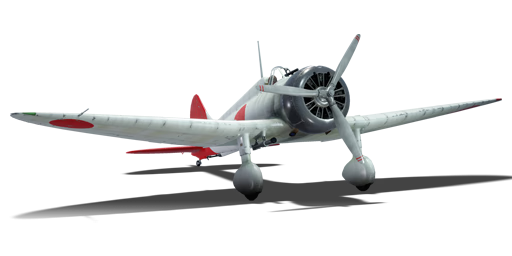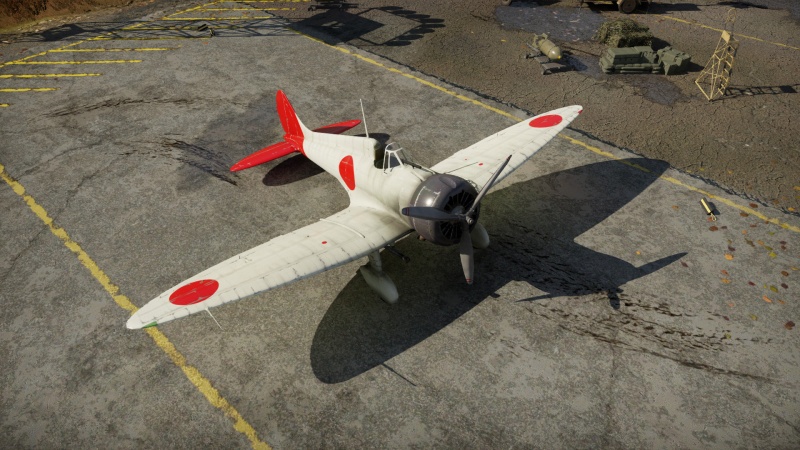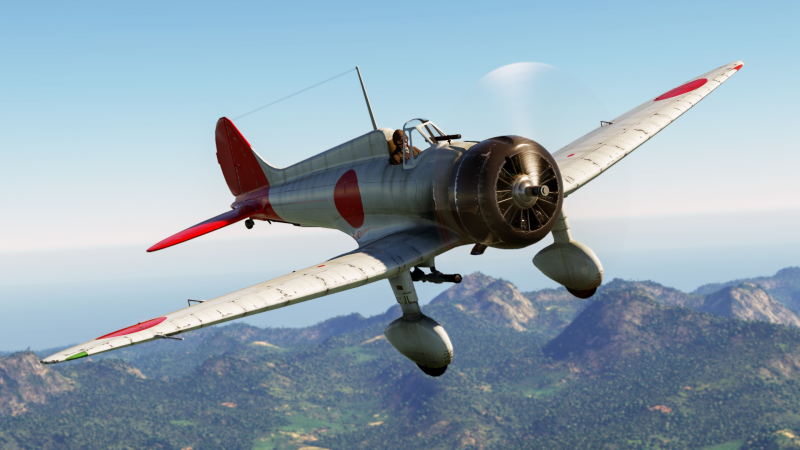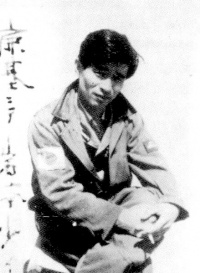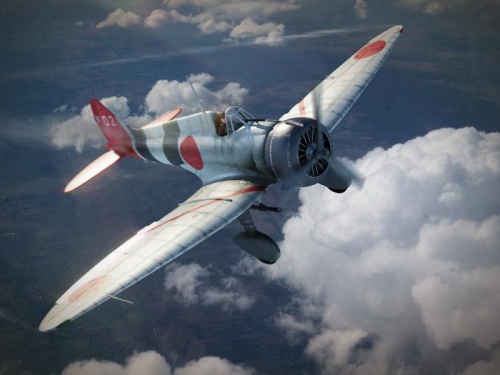Difference between revisions of "A5M4"
(Edits) |
|||
| (18 intermediate revisions by 5 users not shown) | |||
| Line 1: | Line 1: | ||
| − | |||
{{About | {{About | ||
| about = Japanese fighter '''{{PAGENAME}}''' | | about = Japanese fighter '''{{PAGENAME}}''' | ||
| usage = the premium version | | usage = the premium version | ||
| link = Hagiri's A5M4 | | link = Hagiri's A5M4 | ||
| + | }} | ||
| + | {{Specs-Card | ||
| + | |code=a5m4 | ||
| + | |images={{Specs-Card-Image|GarageImage_{{PAGENAME}}.jpg|ArtImage_{{PAGENAME}}.png}} | ||
}} | }} | ||
== Description == | == Description == | ||
<!-- ''In the description, the first part should be about the history of and the creation and combat usage of the aircraft, as well as its key features. In the second part, tell the reader about the aircraft in the game. Insert a screenshot of the vehicle, so that if the novice player does not remember the vehicle by name, he will immediately understand what kind of vehicle the article is talking about.'' --> | <!-- ''In the description, the first part should be about the history of and the creation and combat usage of the aircraft, as well as its key features. In the second part, tell the reader about the aircraft in the game. Insert a screenshot of the vehicle, so that if the novice player does not remember the vehicle by name, he will immediately understand what kind of vehicle the article is talking about.'' --> | ||
| − | |||
| − | |||
| − | |||
| − | The Allied reporting name | + | The '''A5M''', designated as the '''Type 96 Carrier-based Fighter ({{Annotation|九六式艦上戦闘機|Kyū Roku Shiki Kanjō Sentōki}})''', was the world's first carrier-borne monoplane, developed by Mitsubishi for the {{Annotation|IJNAS|Imperial Japanese Navy Air Service}} in 1934 and adopted in 1936. Being a marvel of early aviation, the A5M, which started out as company designation Ka-14, was a creation of Jiro Horikoshi and his team (the designer that would later develop the famous [[A6M (Family)|A6M 'Zero']]). Serving the Navy well during the Second Sino-Japanese War, it took part in the world's first aerial skirmishes between monoplane fighters built of mostly metal against Chinese [[P-26 (Family)|P-26 'Peashooters']], where it outperformed the Chinese aerial units by manoeuvrability and robust construction. This early workhorse of the Imperial Navy Air Service was highly favoured by its aircrews and fared well in battle. By 1938, the main rival of the A5M would become the fast and heavily armed [[I-16 (Family)|Polikarpov I-16]] flown by both Chinese pilots and Soviet volunteers. |
| + | |||
| + | The '''{{Specs|name}}''' has been in the game since the start of the Open Beta Test prior to Update 1.27, and translates exactly over from reality, leading in monoplane manoeuvrability at the early ranks. It allows the pilot to evade and manoeuvre around their adversaries, as well as a presenting a decent airframe that can take a beating from regular munitions. However, it lacks in damage output, being equipped only with two 7.7 mm machine guns. | ||
| + | |||
| + | ;Nicknames | ||
| + | * Allied reporting name: ''Claude''. | ||
== General info == | == General info == | ||
=== Flight performance === | === Flight performance === | ||
| + | {{Specs-Avia-Flight}} | ||
<!-- ''Describe how the aircraft behaves in the air. Speed, manoeuvrability, acceleration and allowable loads - these are the most important characteristics of the vehicle.'' --> | <!-- ''Describe how the aircraft behaves in the air. Speed, manoeuvrability, acceleration and allowable loads - these are the most important characteristics of the vehicle.'' --> | ||
| Line 58: | Line 64: | ||
! Combat !! Take-off !! Landing !! + !! - | ! Combat !! Take-off !! Landing !! + !! - | ||
|- | |- | ||
| − | | {{Specs|destruction|body}} || {{Specs|destruction|gear}} || | + | | 558 <!-- {{Specs|destruction|body}} --> || {{Specs|destruction|gear}} || 398 || 369 || 220 || ~12 || ~4 |
|- | |- | ||
|} | |} | ||
| Line 138: | Line 144: | ||
=== Survivability and armour === | === Survivability and armour === | ||
| + | {{Specs-Avia-Armour}} | ||
<!-- ''Examine the survivability of the aircraft. Note how vulnerable the structure is and how secure the pilot is, whether the fuel tanks are armoured, etc. Describe the armour, if there is any, and also mention the vulnerability of other critical aircraft systems.'' --> | <!-- ''Examine the survivability of the aircraft. Note how vulnerable the structure is and how secure the pilot is, whether the fuel tanks are armoured, etc. Describe the armour, if there is any, and also mention the vulnerability of other critical aircraft systems.'' --> | ||
Like most Japanese planes, the A5M4 has no armour to protect the pilot and components of the plane. The best way to survive is to turn fight. Join a dogfight, make sure you can see your enemy at all times because it will only take a few good hits to the pilot or components to put this plane out of action. | Like most Japanese planes, the A5M4 has no armour to protect the pilot and components of the plane. The best way to survive is to turn fight. Join a dogfight, make sure you can see your enemy at all times because it will only take a few good hits to the pilot or components to put this plane out of action. | ||
| + | |||
| + | === Modifications and economy === | ||
| + | {{Specs-Economy}} | ||
== Armaments == | == Armaments == | ||
| + | {{Specs-Avia-Armaments}} | ||
=== Offensive armament === | === Offensive armament === | ||
| + | {{Specs-Avia-Offensive}} | ||
<!-- ''Describe the offensive armament of the aircraft, if any. Describe how effective the cannons and machine guns are in a battle, and also what belts or drums are better to use. If there is no offensive weaponry, delete this subsection.'' --> | <!-- ''Describe the offensive armament of the aircraft, if any. Describe how effective the cannons and machine guns are in a battle, and also what belts or drums are better to use. If there is no offensive weaponry, delete this subsection.'' --> | ||
{{main|Type 89 (7.7 mm)}} | {{main|Type 89 (7.7 mm)}} | ||
| Line 149: | Line 161: | ||
* 2 x 7.7 mm Type 89 machine guns, nose-mounted (500 rpg = 1,000 total) | * 2 x 7.7 mm Type 89 machine guns, nose-mounted (500 rpg = 1,000 total) | ||
| + | |||
| + | === Suspended armament === | ||
| + | {{Specs-Avia-Suspended}} | ||
| + | <!-- ''Describe the aircraft's suspended armament: additional cannons under the wings, bombs, rockets and torpedoes. This section is especially important for bombers and attackers. If there is no suspended weaponry remove this subsection.'' --> | ||
| + | {{main|Navy Type 97 Number 6 (60 kg)}} | ||
| + | |||
| + | The '''''{{PAGENAME}}''''' can be outfitted with the following ordnance: | ||
| + | |||
| + | * Without load | ||
| + | * 2 x 60 kg Navy Type 97 Number 6 bombs (120 kg total) | ||
== Usage in battles == | == Usage in battles == | ||
| Line 175: | Line 197: | ||
! Oil !! Water !! Type | ! Oil !! Water !! Type | ||
|- | |- | ||
| − | | Controllable || Controllable<br>Not auto controlled || Controllable<br> | + | | Controllable || Controllable<br>Not auto controlled || Controllable<br>Auto control available || Controllable<br>Auto control available || Separate || Not controllable<br>1 gear || Not controllable |
| − | |||
| − | |||
| − | |||
| − | |||
| − | |||
| − | |||
| − | |||
| − | |||
| − | |||
| − | |||
| − | |||
| − | |||
| − | |||
| − | |||
| − | |||
| − | |||
| − | |||
| − | |||
| − | |||
| − | |||
| − | |||
| − | |||
| − | |||
| − | |||
| − | |||
| − | |||
| − | |||
| − | |||
| − | |||
| − | |||
| − | |||
| − | |||
| − | |||
|- | |- | ||
|} | |} | ||
| Line 217: | Line 206: | ||
'''Pros:''' | '''Pros:''' | ||
| − | * | + | * '''A'''5M for Carrier-based fighter: |
| − | * Good visibility (In cockpit view) | + | ** Arrestor hook |
| − | * Low stall speed | + | ** Strictly air-to-air role |
| − | * Fixed landing gear makes landings easier | + | ** Extremely manoeuvrable |
| − | + | *** Excellent turn rate | |
| + | ** Very short takeoff distance | ||
| + | |||
| + | * Common Navy plane construction: | ||
| + | ** Excellent manoeuvrability | ||
| + | ** Nose mounted armament | ||
| + | |||
| + | * '''A5M''' specific: | ||
| + | ** Good visibility (In cockpit view) | ||
| + | ** Low stall speed | ||
| + | ** Fixed landing gear makes landings easier | ||
'''Cons:''' | '''Cons:''' | ||
| − | * | + | * '''A'''5M for Carrier-based fighter: |
| − | * Fixed landing gear creates more drag | + | ** Slow |
| − | * | + | ** Low dive speed, and easily compressed in a dive |
| − | * Suffers from fuel starvation problems (RB/SB) | + | |
| + | * Common Navy plane construction: | ||
| + | ** Poor offensive armament: [[Type 89 (7.7 mm)|7.7 mm Type 89 MG]] | ||
| + | ** Fragile, little armour, and no self-sealing fuel tanks | ||
| + | |||
| + | * '''A5M''' specific: | ||
| + | ** Exposed pilot | ||
| + | ** Fixed landing gear creates more drag | ||
| + | ** Suffers from fuel starvation problems (RB/SB) | ||
== History == | == History == | ||
<!-- ''Describe the history of the creation and combat usage of the aircraft in more detail than in the introduction. If the historical reference turns out to be too long, take it to a separate article, taking a link to the article about the vehicle and adding a block "/History" (example: <nowiki>https://wiki.warthunder.com/(Vehicle-name)/History</nowiki>) and add a link to it here using the <code>main</code> template. Be sure to reference text and sources by using <code><nowiki><ref></ref></nowiki></code>, as well as adding them at the end of the article with <code><nowiki><references /></nowiki></code>. This section may also include the vehicle's dev blog entry (if applicable) and the in-game encyclopedia description (under <code><nowiki>=== In-game description ===</nowiki></code>, also if applicable).'' --> | <!-- ''Describe the history of the creation and combat usage of the aircraft in more detail than in the introduction. If the historical reference turns out to be too long, take it to a separate article, taking a link to the article about the vehicle and adding a block "/History" (example: <nowiki>https://wiki.warthunder.com/(Vehicle-name)/History</nowiki>) and add a link to it here using the <code>main</code> template. Be sure to reference text and sources by using <code><nowiki><ref></ref></nowiki></code>, as well as adding them at the end of the article with <code><nowiki><references /></nowiki></code>. This section may also include the vehicle's dev blog entry (if applicable) and the in-game encyclopedia description (under <code><nowiki>=== In-game description ===</nowiki></code>, also if applicable).'' --> | ||
| − | + | {{break}} | |
| + | {{Navigation-Start|{{Annotation|Archive of the in-game description|An archive of the historical description of the vehicle that was presented in-game prior to Update 1.55 'Royal Armour'}}|expand=true}} | ||
| + | {{Navigation-First-Simple-Line}} | ||
A single-seater, carrier-based, all-metal monoplane fighter with an open cockpit and fixed landing gear. The world's first carrier-based monoplane. A prototype of this fighter first flew on February 4, 1935. After extensive adjustments, the fighter was commissioned by the Japanese navy and designated carrier fighter type 96 (A5M). Mass production began in the fall of 1936. | A single-seater, carrier-based, all-metal monoplane fighter with an open cockpit and fixed landing gear. The world's first carrier-based monoplane. A prototype of this fighter first flew on February 4, 1935. After extensive adjustments, the fighter was commissioned by the Japanese navy and designated carrier fighter type 96 (A5M). Mass production began in the fall of 1936. | ||
| Line 244: | Line 253: | ||
The A5M fighter saw action over China from September 1937 to September 1941. It was also active early on in the war in the Pacific, used for some time to defend Japan and the Marshall Islands. Afterwards, it was used for training missions and flight school. In 1945, the remaining A5M fighters were used for kamikaze missions. | The A5M fighter saw action over China from September 1937 to September 1941. It was also active early on in the war in the Pacific, used for some time to defend Japan and the Marshall Islands. Afterwards, it was used for training missions and flight school. In 1945, the remaining A5M fighters were used for kamikaze missions. | ||
| − | Overall, the A5M met the contemporary requirements for a fighter. It was stable and | + | Overall, the A5M met the contemporary requirements for a fighter. It was stable and manoeuvrable and was easy to control. However, the fighter's construction did not easily allow for upgrades, and it quickly became obsolete. Its armament was poor, its armour non-existent, its fuel tanks not self-sealing, and its wings overly weak. |
Production of the A5M ceased in 1941. A total of 1,095 A5M fighters (of all variants) were produced. | Production of the A5M ceased in 1941. A total of 1,095 A5M fighters (of all variants) were produced. | ||
| + | {{Navigation-End}} | ||
=== Notable pilots === | === Notable pilots === | ||
| Line 259: | Line 269: | ||
;Skins | ;Skins | ||
| − | * [https://live.warthunder.com/feed/camouflages/? | + | * [https://live.warthunder.com/feed/camouflages/?vehicle=a5m4 Skins and camouflages for the {{PAGENAME}} on live.warthunder.com.] |
;Images | ;Images | ||
| − | < | + | <gallery mode="packed-hover" heights="250"> |
| − | + | First battle a5m4.jpg|Graphic of the {{PAGENAME}} player will see after completing the first battle in the airplane | |
| − | </ | + | </gallery> |
;Videos | ;Videos | ||
| Line 270: | Line 280: | ||
== See also == | == See also == | ||
| − | ''Links to the articles on the War Thunder Wiki that you think will be useful for the reader, for example:'' | + | <!-- ''Links to the articles on the War Thunder Wiki that you think will be useful for the reader, for example:'' |
* ''reference to the series of the aircraft;'' | * ''reference to the series of the aircraft;'' | ||
| − | * ''links to approximate analogues of other nations and research trees.'' | + | * ''links to approximate analogues of other nations and research trees.'' --> |
| + | |||
| + | ;Related development | ||
| + | * [[Hagiri's A5M4]] | ||
| + | |||
| + | ;Aircraft of comparable role, configuration and era | ||
| + | * [[Ki-27 otsu]] | ||
| + | * [[F2A (Family)]] | ||
| + | * [[P-26 (Family)]] | ||
| + | * [[G.50 (Family)]] | ||
| + | * [[I-16 (Family)]] | ||
== External links == | == External links == | ||
<!-- ''Paste links to sources and external resources, such as:'' | <!-- ''Paste links to sources and external resources, such as:'' | ||
* ''topic on the official game forum;'' | * ''topic on the official game forum;'' | ||
| − | |||
* ''other literature.'' --> | * ''other literature.'' --> | ||
Latest revision as of 09:05, 16 December 2023
| This page is about the Japanese fighter A5M4. For the premium version, see Hagiri's A5M4. |
Contents
Description
The A5M, designated as the Type 96 Carrier-based Fighter (九六式艦上戦闘機), was the world's first carrier-borne monoplane, developed by Mitsubishi for the IJNAS in 1934 and adopted in 1936. Being a marvel of early aviation, the A5M, which started out as company designation Ka-14, was a creation of Jiro Horikoshi and his team (the designer that would later develop the famous A6M 'Zero'). Serving the Navy well during the Second Sino-Japanese War, it took part in the world's first aerial skirmishes between monoplane fighters built of mostly metal against Chinese P-26 'Peashooters', where it outperformed the Chinese aerial units by manoeuvrability and robust construction. This early workhorse of the Imperial Navy Air Service was highly favoured by its aircrews and fared well in battle. By 1938, the main rival of the A5M would become the fast and heavily armed Polikarpov I-16 flown by both Chinese pilots and Soviet volunteers.
The A5M4 has been in the game since the start of the Open Beta Test prior to Update 1.27, and translates exactly over from reality, leading in monoplane manoeuvrability at the early ranks. It allows the pilot to evade and manoeuvre around their adversaries, as well as a presenting a decent airframe that can take a beating from regular munitions. However, it lacks in damage output, being equipped only with two 7.7 mm machine guns.
- Nicknames
- Allied reporting name: Claude.
General info
Flight performance
| Characteristics | Max Speed (km/h at 2,900 m) |
Max altitude (metres) |
Turn time (seconds) |
Rate of climb (metres/second) |
Take-off run (metres) | |||
|---|---|---|---|---|---|---|---|---|
| AB | RB | AB | RB | AB | RB | |||
| Stock | 431 | 421 | 9800 | 12.5 | 13.4 | 10.0 | 10.0 | 325 |
| Upgraded | 464 | 447 | 12.1 | 12.3 | 16.7 | 12.8 | ||
Details
| Features | ||||
|---|---|---|---|---|
| Combat flaps | Take-off flaps | Landing flaps | Air brakes | Arrestor gear |
| ✓ | ✓ | ✓ | X | ✓ |
| Limits | ||||||
|---|---|---|---|---|---|---|
| Wings (km/h) | Gear (km/h) | Flaps (km/h) | Max Static G | |||
| Combat | Take-off | Landing | + | - | ||
| 558 | 558 | 398 | 369 | 220 | ~12 | ~4 |
| Optimal velocities (km/h) | |||
|---|---|---|---|
| Ailerons | Rudder | Elevators | Radiator |
| < 280 | < 320 | < 360 | > 324 |
| Compressor (RB/SB) | ||
|---|---|---|
| Setting 1 | ||
| Optimal altitude | 100% Engine power | WEP Engine power |
| 2,000 m | 680 hp | 788 hp |
Engine performance
| Engine | |||||
|---|---|---|---|---|---|
| Engine Name | Number present | ||||
| Nakajima Kotobuki 41 9-cylinder | 1 | ||||
| Engine characteristics | |||||
| Weight (each) | Type | Cooling | |||
| 350 kg | Radial | Air | |||
| Engine power (Stock) | |||||
| Mode | Max | Take-off | |||
| Arcade | 557 hp | 656 hp | |||
| Realistic/Simulator | 551 hp | 650 hp | |||
| Engine power (Upgraded) | |||||
| Mode | Max | Take-off | |||
| Arcade | 700 hp | 799 hp | |||
| Realistic/Simulator | 619 hp | 718 hp | |||
| WEP Duration | |||
|---|---|---|---|
| Arcade | Realistic/Simulator | ||
| 25 seconds | Infinite | ||
Survivability and armour
Like most Japanese planes, the A5M4 has no armour to protect the pilot and components of the plane. The best way to survive is to turn fight. Join a dogfight, make sure you can see your enemy at all times because it will only take a few good hits to the pilot or components to put this plane out of action.
Modifications and economy
Armaments
Offensive armament
The A5M4 is armed with:
- 2 x 7.7 mm Type 89 machine guns, nose-mounted (500 rpg = 1,000 total)
Suspended armament
The A5M4 can be outfitted with the following ordnance:
- Without load
- 2 x 60 kg Navy Type 97 Number 6 bombs (120 kg total)
Usage in battles
Fighter role, staying low and using the extremely quick turn times to get on the tail on the enemy is essential. Keep an eye on ammo levels and well as your surroundings, this is an extremely weak aircraft in terms of armour. It is relatively fast in a straight line, but not as quick as much of the opposition it will be facing in the game. It is recommended to use speed against biplanes as their turn times are nearly matched if not better than this monoplane.
Realistic battles
The A5M4 can accelerate to 350 km/h in just less than a minutes time from takeoff. Will climb up to 2,500 m in around one minute and fifty seconds time when climbing in a 20-degree angle. Dive speeds are decent as the A5M4 will exceed 550 km/h in an 80-degree angle from just 2,500 m height. Be careful though, once the A5M4 reaches 560 km/h, the plane will violently shake about and if the throttle isn't cut, the plane wings may rip off. Though speed can be gained in the dive, energy is not easily retained, taking only a minute or so to fall to back to the maximum speed of 380 km/h with WEP or 360 km/h without.
Decent horsepower with the typical Japanese light aircraft would give the idea that the plane would be great in the vertical axis dog fighting. With a problem with keeping constant fuel flow as the plane changes the angle on its vertical axis means it is better to stick with horizontal dog fighting which isn't a bad thing as it will outturn most all contemporary aircraft.
Simulator mode procedures
Hands-off carrier take-off (Auto engine control): Ignite engine, flaps: raised, elevator trim: 6% up, aileron trim: 0%, rudder trim: 21% right, WEP throttle, hands off controls until the plane lifts off the carrier.
Manual Engine Control
| MEC elements | ||||||
|---|---|---|---|---|---|---|
| Mixer | Pitch | Radiator | Supercharger | Turbocharger | ||
| Oil | Water | Type | ||||
| Controllable | Controllable Not auto controlled |
Controllable Auto control available |
Controllable Auto control available |
Separate | Not controllable 1 gear |
Not controllable |
Pros and cons
Pros:
- A5M for Carrier-based fighter:
- Arrestor hook
- Strictly air-to-air role
- Extremely manoeuvrable
- Excellent turn rate
- Very short takeoff distance
- Common Navy plane construction:
- Excellent manoeuvrability
- Nose mounted armament
- A5M specific:
- Good visibility (In cockpit view)
- Low stall speed
- Fixed landing gear makes landings easier
Cons:
- A5M for Carrier-based fighter:
- Slow
- Low dive speed, and easily compressed in a dive
- Common Navy plane construction:
- Poor offensive armament: 7.7 mm Type 89 MG
- Fragile, little armour, and no self-sealing fuel tanks
- A5M specific:
- Exposed pilot
- Fixed landing gear creates more drag
- Suffers from fuel starvation problems (RB/SB)
History
| Archive of the in-game description | |
|---|---|
|
A single-seater, carrier-based, all-metal monoplane fighter with an open cockpit and fixed landing gear. The world's first carrier-based monoplane. A prototype of this fighter first flew on February 4, 1935. After extensive adjustments, the fighter was commissioned by the Japanese navy and designated carrier fighter type 96 (A5M). Mass production began in the fall of 1936. In 1938, the fine-tuned A5M4 (model 4, later re-designated the model 24) variant was launched. This model had several new features: a new, more streamlined cockpit canopy with improved visibility, advanced fairings, and a radio transmitter. Since bombers often had to operate in the dark, the plane had landing lights and lights for flights over the open seas at night. The plane was equipped with a film camera near the left of the landing gear. The power plant was a 9-cylinder radial air-cooled Nakajima Kotobuki 41 with a rated capacity of 795 horsepower. The plane had a two-bladed (later three-bladed) wooden variable pitch propellor, the Sumitomo VDM. Later planes began to use the Kotobuki 41KAI engine (which had roughly the same power), a design designated as model 34. The A5M's armament consisted of two fuselage-mounted synchronous 7.7mm Nippon-Seikosho type 89 model 2 (Vickers "class E") machine guns with 500 rounds of ammunition each. Two 30-kg type 97 bombs could be carried under the wings. Under the fuselage, an additional 160-liter fuel tank could be carried. Later, this fuel tank was increased in size to 210 liters. The A5M fighter saw action over China from September 1937 to September 1941. It was also active early on in the war in the Pacific, used for some time to defend Japan and the Marshall Islands. Afterwards, it was used for training missions and flight school. In 1945, the remaining A5M fighters were used for kamikaze missions. Overall, the A5M met the contemporary requirements for a fighter. It was stable and manoeuvrable and was easy to control. However, the fighter's construction did not easily allow for upgrades, and it quickly became obsolete. Its armament was poor, its armour non-existent, its fuel tanks not self-sealing, and its wings overly weak. Production of the A5M ceased in 1941. A total of 1,095 A5M fighters (of all variants) were produced. | |
Notable pilots
Media
- Skins
- Images
- Videos
See also
- Related development
- Aircraft of comparable role, configuration and era
External links
| Mitsubishi Company (三菱商会) | |
|---|---|
| Fighters | A5M4 · Hagiri's A5M4 |
| A6M2 mod. 11 · A6M2 · A6M3 · A6M3 mod. 22 · A6M3 mod. 22Ko · A6M5 · A6M5 Ko · A6M5 otsu · A6M5 Hei · A6M6c | |
| A7M1 (NK9H) · A7M2 | |
| J2M2 · J2M3 · J2M4 Kai · J2M5 · J2M5 (30 mm) | |
| Hydroplanes | F1M2 |
| Interceptors | Ki-83 · Ki-109 |
| Bombers | G4M1 |
| Ki-21-Ia · Ki-21-I hei · Ki-67-I Ko · Ki-67-I otsu | |
| Jet Fighters | Ki-200 |
| Captured | ▃A6M2 · ␗A6M2 |
| See also | Mitsubishi Heavy Industries, Ltd. (Post-War) |
| Japan fighters | |
|---|---|
| Navy | |
| Carrier-based fighter | |
| A5M | A5M4 · Hagiri's A5M4 |
| A6M | A6M2 mod. 11 · A6M2 · A6M3 · A6M3 mod. 22 · A6M3 mod. 22Ko · A6M5 · A6M5 Ko · A6M5 otsu · A6M5 Hei · A6M6c |
| A7He | A7He1* |
| A7M | A7M1 (NK9H) · A7M2 |
| Land-based Fighter | |
| J2M | J2M2 · J2M3 · J2M4 Kai · J2M5 · J2M5 (30 mm) |
| J6K | J6K1 |
| J7W | J7W1 |
| N1K-J | N1K1-Ja · N1K2-J · N1K2-Ja |
| Fighter seaplane | |
| N1K | N1K1 |
| A6M-N | A6M2-N |
| Army | |
| Ki-10 | Ki-10-I · Ki-10-I C · Ki-10-II · Ki-10-II C |
| Ki-27 | Ki-27 otsu · Ki-27 otsu Tachiarai |
| Ki-43 | Ki-43-I · Ki-43-II · Ki-43-III otsu |
| Ki-44 | Ki-44-I · Ki-44-I 34 · Ki-44-II otsu · Ki-44-II hei |
| Ki-61 | Ki-61-I ko · Ki-61-I otsu · Ki-61-I hei · Tada's Ki-61-I hei · Ki-61-I tei · Ki-61-II Otsu Kai |
| Ki-84 | Ki-84 ko · Ki-84 otsu · Ki-84 hei |
| Ki-87 | Ki-87 |
| Ki-94 | Ki-94-II |
| Ki-100 | Ki-100 · Ki-100-II |
| Other countries | ▅F4U-1A · ▅P-51C-11-NT · ▅Bf 109 E-7 · ▅Fw 190 A-5 |
| *Imported designation of the He 112 (A6M was in development - A7M would take A7 designation after the cancelation of the A7He) | |


